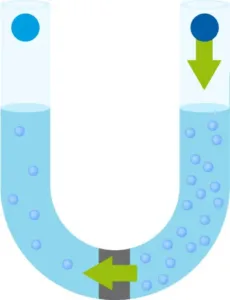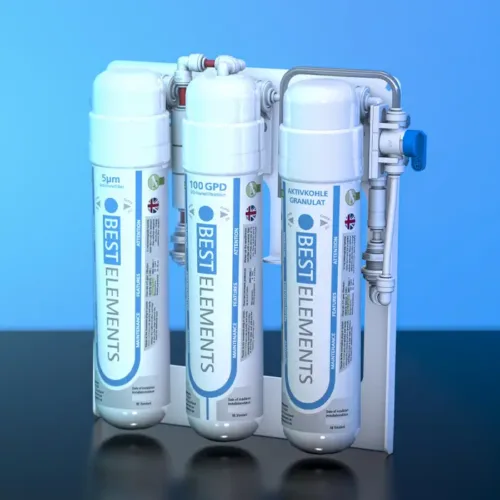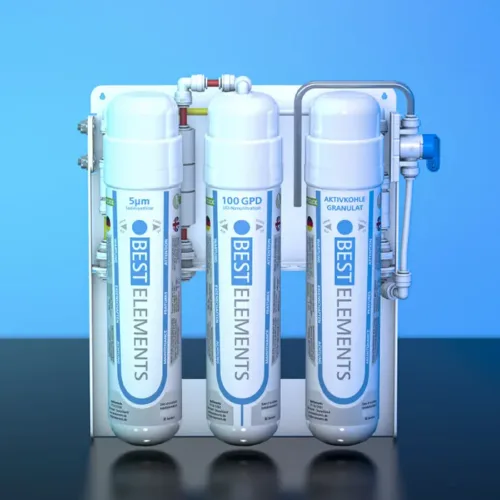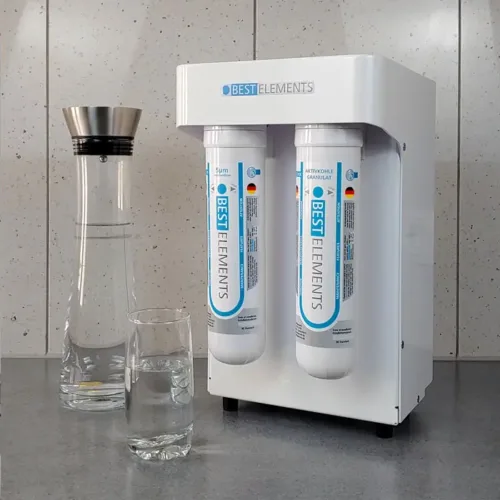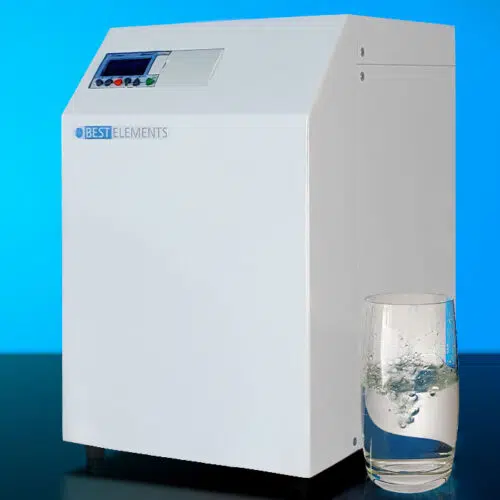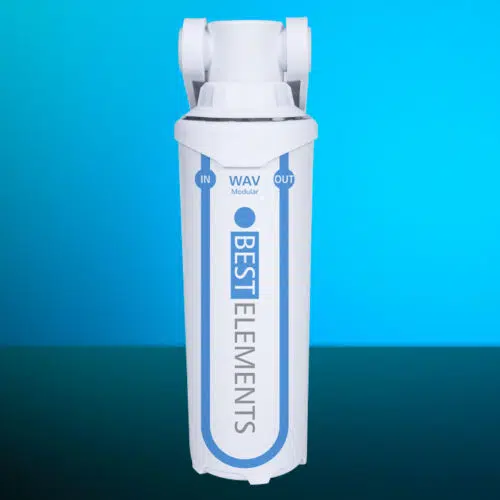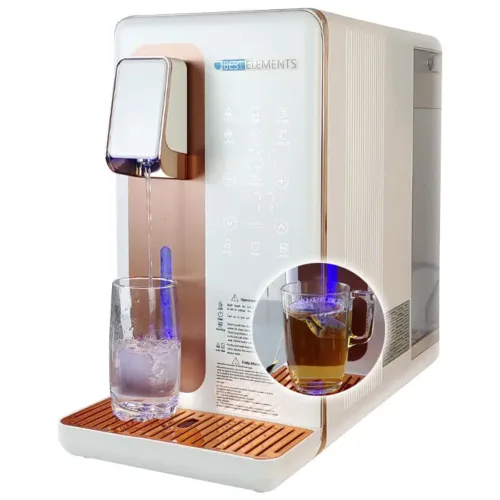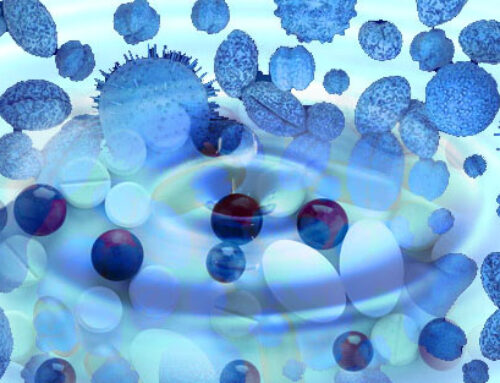Biological, natural, vital
Osmosis is a biological, natural and vital process that happens permanently in our cells and other living beings. Osmosis represents the saturation balance that our cell water strives to achieve in the body.
When consuming salt water or other liquids saturated with additives, for example, these get into the organism, but do not yet penetrate the body cells. The cell walls, also called cell membranes, form a barrier, but they are semi-permeable. This means that water molecules get through, but larger solutes cannot. The osmotic pressure even increases the water column in the experimental setup shown.
█ Ultrapure water █ Raw water (also salt water) █ Semi-permeable membrane █ Osmotic pressure █ Pressure applied
Comparison of purity of filtration technologies
This effect of the semipermeable membrane is used in reverse osmosis. Conversely, if you exert pressure on the saturated solution, only pure water molecules pass through the semi-permeable membrane.
The principle was developed a few decades ago and was also used by NASA to recycle fluids in space to supply astronauts. Reverse osmosis is also used in water desalination plants.
In our body, in an effort to balance saturation, water gets out of our cells into saturated solutions to dilute them. If there is too much salt water, a lot of water is withdrawn from the cells and the organism runs the risk of drying out, despite the (salt) water excess in the body.
Conversely, only pure water molecules from the body get through semi-permeable membranes into our cells. The Aquaporine process ensures that foreign substances remain outside the cell.
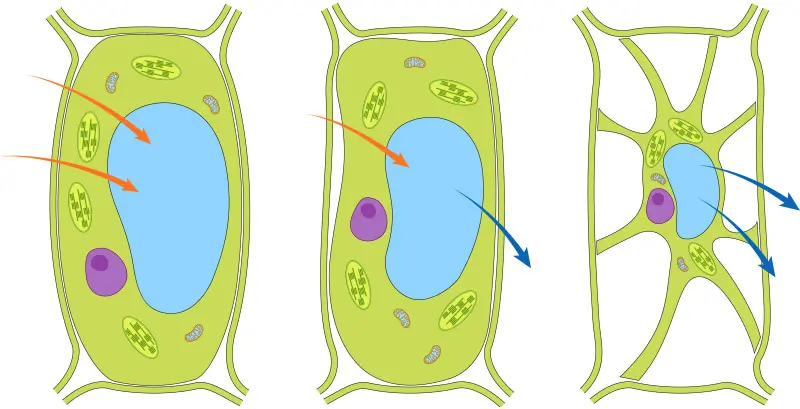
Reverse osmosis filter systems in the household
At the end of the 20th century, the first reverse osmosis filter systems, occasionally also known as molecular filters, were developed for households. The actual filter process takes place completely without chemicals and without electricity and achieves a purity via nanofiltration. Technological materials that hold back substances that are larger than water molecules are used as the semi-permeable membrane. And since water molecules are one of the smallest elements, the filter effect is enormous and thorough. Up to 99% of the foreign matter can be removed in this way. This purity is not achieved by any other economically sensible technology that can be used in households. In addition to bacteria, pesticides and nitrates, antibiotics, medical and drug residues, dissolved salts, amino acids, dyes, chlorine, odorous substances, viruses and many other undesirable components are also removed.
Distillation is another process that has nothing to do with reverse osmosis technology. Various volatile substances can still be contained in the distillation process.
Limited drinking water resource
Water is not created anew on earth, we have lived with this limited supply of water for thousands of years. Only around 2.5% of all water resources on earth are available as fresh water – including icebergs and glaciers.
The water cycle with evaporation, condensation as rain and recycling happens continuously on earth and all impurities that are introduced into the cycle and cannot be removed by waterworks are permanently included in the cycle.

Approx. 40-50 substances are tested in drinking water in accordance with the requirements of the Drinking Water Ordinance. According to public sources , water can “easily contain 1,500 substances of anthropogenic origin”. Including pollution from environmental toxins, industrial residues, manure fertilization from factory farming, medication, drugs, hormones, bacteria. The WHO requires the testing of “200 substances because of their known effects on health” *. One reads more often about bacterial alarms and other drinking water alarms in the press releases. In the meantime, many reports have reported on the presence of untested substances in water in Germany as well. The limit values have been adjusted and raised more often in the past. For many pollutants there are still no limit values..
Frequent toxins in our environment are heavy metals, according to Raik Garve. Arsenic, lead, mercury as well as aluminum and other substances such as hormone-like substances and microplastics are pollution, that can be detected in many people. They interfere with the functioning of enzymes in our body, which can lead to chronic diseases.

High quality and safe reverse osmosis filter devices can remove these contaminants from drinking water. Bacteria, viruses, lime and many other unwanted components are also removed. There are now many models of reverse osmosis filter devices in various performance and price ranges on the market. Material purity, performance values and long-term safety are decisive for these filter devices. Pure drinking water must be reliably guaranteed and materials must not inadvertently release substances into the water. Also water taps, which in many cases are made of metal alloys and have direct contact with drinking water, must be taken into account. The Commission checks important criteria for filter systems and issues corresponding certificates.
You are what you eat drink.
We consume approx. 550 kg of drinking water per year, as opposed to approx. 365 kg of food. This makes it clear that the purity of drinking water plays a major role for the body. Source
The enrichment of drinking water with gaseous dissolved hydrogen as a natural antioxidant can help to bind and remove free radicals in the cells. Vitamins are also hydrogen compounds. An increased content of gaseous dissolved hydrogen could be detected in so-called healing springs.
Where can I get minerals from without mineral water?
Rainwater contains no minerals and has supplied plants, animals and people for thousands of years. Essential minerals are generally ingested with food. Even on mineral bottles there is a note: „Pay attention to a balanced diet … [read more]
What about energizing water?
Depending on the temperature, water molecules are grouped in so-called clusters. This cluster structure changes very often every second. When frozen, this structure, which consists of thousands of molecules, can be photographed as a snow crystal… [read more]


